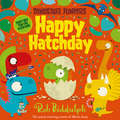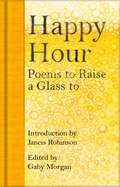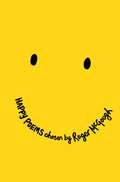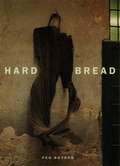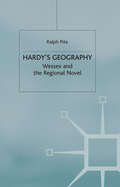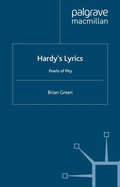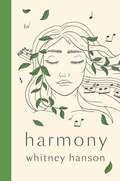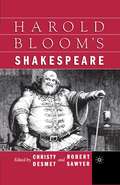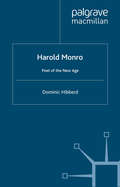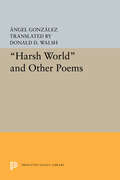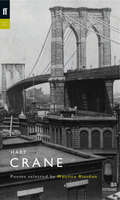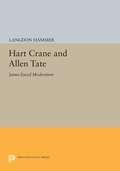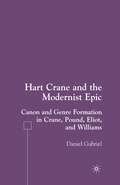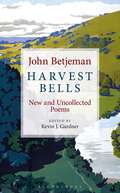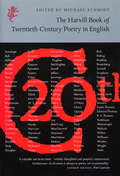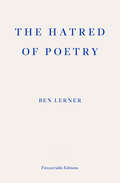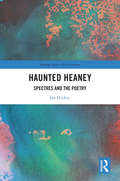- Table View
- List View
Happy Hatchday (Dinosaur Juniors #1)
by Rob BiddulphThe first series from the bestselling and award-winning picture book genius Rob Biddulph!
Happy Hour: Poems to Raise a Glass to (Macmillan Collector's Library #315)
by Jancis Robinson and Gaby MorganWe raise a glass with friends and we drink in solitude to remember and to forget. Drink gives us the courage to love and comfort when we lose. All this and more is captured in this rich poetry anthology.Part of the Macmillan Collector’s Library; a series of stunning, pocket-sized classics with ribbon markers. These beautiful books make perfect gifts or a treat for any book lover. This edition features an introduction by wine critic Jancis Robinson.Many of the most famous poets have weaved the delights and temptations of drink into their verse. In Happy Hour: Poems to Raise a Glass To, there are chapters on whisky and beer, celebrations, why we drink and where we go to do it. Robert Burns is here, of course, alongside Yeats, Keats, Emily Dickinson, Hilaire Belloc, Sara Teasdale, Edward Lear, G. K. Chesterton and many more.
Happy Poems
by Roger McGoughPoems to make you smile! Critically acclaimed poet Roger McGough has drawn together a fantastic collection of upbeat poems to bring happiness into your day with this uplifting collection Happy Poems. He reminds us that happiness can be found all around us in the everyday, in family, in books in nature and, of course, in our pets! Includes gems from the very best classic and contemporary poets, such as John Agard, Adrian Henri, Brian Patten, Carol Ann Duffy, Joseph Coelho, William Wordsworth and William Blake.
Hard Bread (Phoenix Poets)
by Peg BoyersThe poems in Peg Boyers's Hard Bread are "spoken" in the imagined voice of the Italian writer, Natalia Ginzburg (1916-91). While much of the book is based on Ginzburg's life—her upbringing in Turin; her brief marriage to the resistance activist, Leone Ginzburg; her experience of Fascism and war; her work as novelist, playwright, editor, and newspaper columnist; her embattled friendships with writers like Primo Levi, Pier Paolo Pasolini, Ernest Hemingway, and Cesare Pavese—much is invented. The result is a book by turns melancholy and acerbic, mournful and satiric, contemplative and combative.
Hard Water
by Jean SpracklandThough firmly rooted in the domestic, natural world, Jean Sprackland's poems are thrilling excursions into the lives that we live alongside our everyday ones: the lives we are aware of in dreams, in grief, in love. She shows us the vertigo and vulnerability of human experience with great clarity and precision, tenderness and care. These are vivid poems full of light and weather and water: a flooded forest, acid rain, an inland tidal wave, an ocean of broken glass; jellyfish washed up on the beach that 'lay like saints/ unharvested, luminous'. There is an arresting imagination at work here, one as relaxed and at home in an alternative world of babies in filing cabinets, light collectors or the visiting dead, as it is in the world we think we know: supermarkets, empty flats, the A580 from Liverpool to Manchester.Lucid, sensuous and informed by an unusually tactile curiosity, the poems in Hard Water mark the assured arrival of an important poet.
Hardy's Geography: Wessex and the Regional Novel
by R. PiteHardy's Geography reconsiders a familiar element in Hardy's novels: their use of place and, specifically, of Dorset. Hardy said his Wessex was a 'partly real, partly dream-country'. This study examines how reality and dream interact in his work. Should we look for a real place corresponding to Casterbridge? What is the relation between one person's feelings for a place and society's view of it. Pite concludes that Hardy addresses these issues through a distinctive regional awareness.
Hardy's Lyrics: Pearls of Pity
by B. GreenThomas Hardy frequently insisted that his poems were not self-expressive, but dramatic or 'impersonative'. Yet biographical expositions have dulled their impersonality. Brian Green's approach is more exacting and rewarding; taking Hardy at his word, he traces Hardy's 'master theme' throughout the corpus of poems - a governing concern which merges Victorian and perennial ideas throughout the whole of Hardy's writings.
Hardy's Poetry, 1860-1928
by D. TaylorHardy insisted that his poetry steadily grew in skill and maturity. Hardy's Poetry, 1860-1928 traces this development. Gradually Hardy makes his lyric poem the model of a man's life: the way the lyric speaker forms his thoughts within the few moments of a reverie recapitulates the way a man has thought over a lifetime; the smaller interruption of the reverie portends the larger interruptions of life. This lyric model is supported by a distinctive imagery of visual patterns whose implications Hardy explores. These patterns come to symbolise the patterns of life and mind which crystallise over a lifetime and are belatedly revealed.
Harm
by Alan JenkinsThe poems in this, Alan Jenkin's third collection, speak of the harm done and suffered - most frequently in the name of love - in the course of lives gone adrift among lost causes, chance meetings and missed chances. A new directness and simplicity, and throughout, a raw urgency of personal feeling, inform a voice that is as resourceful as in Jenkin's earlier volumes, and continues to salvage a 'fugitive lyricism' (as one reviewer put it) from harsh and dissonant realities. 'By turns jocular, disquieting, sexy and inventive'-PETER READING, SUNDAY TIMES 'Jenkins' poetry is exhilarating. . . It is charged with erotic energy, rage, sorrow and confusion'-TLS 'Stylish, Savage, unforgiving'-HUGO WILLIAMS, SUNDAY TELEGRAPH 'Jenkins has a restless mind: following his poetry gives his readers a rocky ride, but also a rewarding one. '-PETER PORTER, OBSERVER.
Harmony: poems to find peace
by Whitney HansonFrom TikTok phenomenon Whitney Hanson, a brand-new collection of poems exploring the progression of a life through the elements of musicIn this collection of all new poems, Whitney Hanson explores the progression of a life through the lens of music. We each begin with a simple note, but as life progresses, we're led to the next note, and the next - all of which combine to form the melody of a song and the cadence of a life. As life becomes more complicated and complex, we find that loss, grief, and heartache can muffle our music, making the world go silent. But as Whitney's poems show, all of these rests and pauses in the music are part of the magnificent composition of life.Broken into four sections - melody, rest, crescendo, and harmony - the poems in Harmony explore childhood, friendship, grief, acceptance, and peace. The result is a collection that emphasizes the beauty of living a life at peace with all its musical variations.
Harold Bloom's Shakespeare
Harold Bloom's Shakespeare examines the sources and impact of Bloom's Shakespearean criticism. Through focused and sustained study of this writer and his best-selling book, this collection of essays addresses a wide range of issues pertinent to both general readers and university classes: the cultural role of Shakespeare and of a new secular humanism addressed to general readers and audiences; the author as literary origin; the persistence of character as a category of literary appreciation; and the influence of Shakespeare within the Anglo-American educational system. Together, the essays reflect on the ethics of literary theory and criticism.
Harold Monro: Poet of the New Age
by D. HibberdTroubled by his complex sexuality, Monro was a tormented soul whose aim was to serve the cause of poetry. Hibberd's revealing and beautifully-written biography will help rescue Monro from the graveyard of literary history and claim for him the recognition he deserves. Poet and businessman, ascetic and alcoholic, socialist and reluctant soldier, twice-married yet homosexual, Harold Monro probably did more than anyone for poetry and poets in the period before and after the Great War, and yet his reward has been near oblivion. Aiming to encourage the poets of the future, he befriended, among many others, T.S. Eliot, Ezra Pound and the Imagists; Rupert Brooke and the Georgians; Marinetti the Futurist; Wilfred Owen and other war poets; and the noted women poets, Charlotte Mew and Amma Wickham.
Harold Norse: Poet Maverick, Gay Laureate (Clemson University Press: Beat Studies)
Who was Harold Norse? Despite publishing over a dozen volumes of poetry between the early 1950s and the new millennium, until now, the Brooklyn-born Norse has been relegated to a footnote in accounts of twentieth century literary history. Harold Norse: Poet Maverick, Gay Laureate is the first collection of essays devoted to this enigmatic poet and visual artist. As this volume explores, Norse, who developed his craft while living in Europe during the 1950s and 1960s, is an important figure in the development of mid-twentieth century poetics. During the 1950s and 1960s, Norse was a notable figure in the plethora of little poetry magazines published in the USA and Europe through to skirmishes with respectability and acceptance (Penguin and City Lights). Norse is a key figure in the development of the cut-up process made famous by his friend, William S. Burroughs. His correspondence with his mentor, the poet William Carlos Williams, captures his poetic shifts from formalism to the development of his Brooklyn idiom, while his gripping autobiography, Memoirs of a Bastard Angel, documents his transatlantic networks of writers and artists, among them James Baldwin, Allen Ginsberg, and Charles Bukowski. And after returning to the US in the late 1960s, Norse emerged as leading figure in Gay Liberation poetry.List of contributors: Jan Herman, Erik Mortenson, A. Robert Lee, Fiona Paton, Daniel Kane, Steven Belletto, Estíbaliz Encarnación-Pinedo, Ronna C. Johnson, Kurt Hemmer, Chad Weidner, Benjamin J. Heal, Tate Swindell, Andrew McMillan, Douglas Field, Jay Jeff Jones, Todd Swindell, andJames Grauerholz.
Harsh World and Other Poems
by Angel Gonzalez Donald D. WalshAlthough seven volumes of his poetry are available in Spanish, the work of Ángel González has not been widely translated into English. This bilingual edition, introduced by the poet, presents selections from Palabra sobre palabra (Word upon Word), his definitive collection. Included are poems from Grado elemental (Elementary Grade), which won the Antonio Machado Prize for Poetry. Born in Oviedo, Spain in 1925, Ángel González published his first book in 1956 to immediate acclaim. His poetry is characterized by striking imagery and deeply personal statement that is often sad and sardonic. Of his work González writes, "'Experience,' 'reality', and 'preciseness of expression' are probably...the boundaries that limit the space, on a horizontal plane, in which my poetic intentions move. Upon this plane, trying to add another dimension, I attempt to erect my creative and imaginative possibilities....In some of these poems, written and published in Spain, the result of a determined desire to bear witness will have to be sought not in what the words say but in what they imply, in the spaces of shadow, of silence of anger, or of helplessness that they discover or uncover."Originally published in 1977.The Princeton Legacy Library uses the latest print-on-demand technology to again make available previously out-of-print books from the distinguished backlist of Princeton University Press. These editions preserve the original texts of these important books while presenting them in durable paperback and hardcover editions. The goal of the Princeton Legacy Library is to vastly increase access to the rich scholarly heritage found in the thousands of books published by Princeton University Press since its founding in 1905.
Hart Crane (Poet To Poet Ser. #41)
by Maurice RiordanHarold Hart Crane was born in Ohio in 1899. In 1923 he became a copy-writer in New York. White Buildings, his first collection, appeared in 1926, and in 1930 his most famous work, The Bridge, was published. A reaction against the pessimism in T. S. Eliot's The Waste Land, The Bridge was a love song to the myth of America and its optimism a much needed boon to post-Wall Street Crash America. Hart Crane committed suicide in 1932.
Hart Crane and Allen Tate: Janus-Faced Modernism
by Langdon HammerFocusing on the vexed friendship between Hart Crane and Allen Tate, this book examines twentieth-century American poetry's progress toward institutional sanction and professional organization, a process in which sexual identities, poetic traditions, and literary occupations were in question and at stake. Langdon Hammer combines biography and formalist analysis to argue that American modernism was a Janus-faced phenomenon, at once emancipatory and elitist, which simultaneously attacked traditional cultural authority and reconstructed it in new forms. Hammer shows how Crane and Tate, working in relation to each other and to T. S. Eliot, created for themselves the competing roles of "genius" and "poet-critic." Crane embraced the self-authorizing powers of the individual talent at the cost of standing outside the emerging consensus of high modernist literary culture, an aesthetic isolation which converged with his social isolation as a gay man. Tate, turning against Crane, linked the modernist defense of tradition to an embattled heterosexual masculinity, while he adapted Eliot's stance to a career sustained by criticism and teaching. Ending his book with a discussion of Robert Lowell's career, Hammer maintains that Lowell's "confessional" poetry recapitulates the conflict enacted by Crane and Tate.Originally published in 1993.The Princeton Legacy Library uses the latest print-on-demand technology to again make available previously out-of-print books from the distinguished backlist of Princeton University Press. These editions preserve the original texts of these important books while presenting them in durable paperback and hardcover editions. The goal of the Princeton Legacy Library is to vastly increase access to the rich scholarly heritage found in the thousands of books published by Princeton University Press since its founding in 1905.
Hart Crane and the Modernist Epic: Canon and Genre Formation in Crane, Pound, Eliot, and Williams
by D. GabrielThis study examines Hart Crane's canonical ambitions in The Bridge and argues for a new species of epic, 'the modernist epic,' which also includes Pound's The Cantos, Eliot's The Waste Land, and Williams's Paterson. It offers a close reading of The Bridge as a hybrid of lyric and epic modes. Crane's sublime and history converge in a complex synthesis of form and ideas. The study reconceives Crane's achievement by locating him in an intertextual system of production while also recognizing his poetic making of self. Yet in this work Crane assumes a greater political presence than much commentary has entertained.
Hart Crane's Poetry: "Appollinaire lived in Paris, I live in Cleveland, Ohio"
by John T. IrwinIn one of his letters Hart Crane wrote, "Appollinaire lived in Paris, I live in Cleveland, Ohio," comparing—misspelling and all—the great French poet’s cosmopolitan roots to his own more modest ones in the midwestern United States. Rebelling against the notion that his work should relate to some European school of thought, Crane defiantly asserted his freedom to be himself, a true American writer. John T. Irwin, long a passionate and brilliant critic of Crane, gives readers the first major interpretation of the poet’s work in decades. Irwin aims to show that Hart Crane’s epic The Bridge is the best twentieth-century long poem in English. Irwin convincingly argues that, compared to other long poems of the century, The Bridge is the richest and most wide-ranging in its mythic and historical resonances, the most inventive in its combination of literary and visual structures, the most subtle and compelling in its psychological underpinnings. Irwin brings a wealth of new and varied scholarship to bear on his critical reading of the work—from art history to biography to classical literature to philosophy—revealing The Bridge to be the near-perfect synthesis of American myth and history that Crane intended.Irwin contends that the most successful entryway to Crane’s notoriously difficult shorter poems is through a close reading of The Bridge. Having admirably accomplished this, Irwin analyzes Crane’s poems in White Buildings and his last poem, "The Broken Tower," through the larger context of his epic, showing how Crane, in the best of these, worked out the structures and images that were fully developed in The Bridge.Thoughtful, deliberate, and extraordinarily learned, this is the most complete and careful reading of Crane’s poetry available. Hart Crane may have lived in Cleveland, Ohio, but, as Irwin masterfully shows, his poems stand among the greatest written in the English language.
Hart Crane's Poetry: "Appollinaire lived in Paris, I live in Cleveland, Ohio"
by John T. IrwinIn one of his letters Hart Crane wrote, "Appollinaire lived in Paris, I live in Cleveland, Ohio," comparing—misspelling and all—the great French poet’s cosmopolitan roots to his own more modest ones in the midwestern United States. Rebelling against the notion that his work should relate to some European school of thought, Crane defiantly asserted his freedom to be himself, a true American writer. John T. Irwin, long a passionate and brilliant critic of Crane, gives readers the first major interpretation of the poet’s work in decades. Irwin aims to show that Hart Crane’s epic The Bridge is the best twentieth-century long poem in English. Irwin convincingly argues that, compared to other long poems of the century, The Bridge is the richest and most wide-ranging in its mythic and historical resonances, the most inventive in its combination of literary and visual structures, the most subtle and compelling in its psychological underpinnings. Irwin brings a wealth of new and varied scholarship to bear on his critical reading of the work—from art history to biography to classical literature to philosophy—revealing The Bridge to be the near-perfect synthesis of American myth and history that Crane intended.Irwin contends that the most successful entryway to Crane’s notoriously difficult shorter poems is through a close reading of The Bridge. Having admirably accomplished this, Irwin analyzes Crane’s poems in White Buildings and his last poem, "The Broken Tower," through the larger context of his epic, showing how Crane, in the best of these, worked out the structures and images that were fully developed in The Bridge.Thoughtful, deliberate, and extraordinarily learned, this is the most complete and careful reading of Crane’s poetry available. Hart Crane may have lived in Cleveland, Ohio, but, as Irwin masterfully shows, his poems stand among the greatest written in the English language.
Hart Crane's Queer Modernist Aesthetic
by N. MunroHart Crane's Queer Modernist Aesthetic argues that the aspects of experience which modernists sought to interrogate – time, space, and material things – were challenged further by Crane's queer poetics. Reading Crane alongside contemporary queer theory shows how he creates an alternative form of modernism.
Harvest Bells: New and Uncollected Poems by John Betjeman
by John BetjemanJohn Betjeman's unforgettable poems on landscape and suburbia, desire and death, faith and doubt, helped to establish him as the beloved voice of a nation. Yet the ten books of poetry he published individually, later assembled in the Collected Poems, were an incomplete representation of his poetic oeuvre. Many poems published in journals or magazines were excluded from Betjeman's books by him or his editors and a substantial number of finished poems were never printed at all, remaining unknown to readers – until now.In this exquisite new edition of Betjeman's verse editor Kevin Gardner promises new treasures for 'Betj's' admirers the world over. Betjeman wrote many of these poems in the late 1920s and early 1930s, when he was still developing his unique poetic voice. They reveal a young poet experimenting with both Modernism and post-Romanticism, yet influenced by Shelley and Pope among others. Some of these poems are profoundly psychological, personal and deeply affecting to read today. Several have the delicate and eccentric touch of much of his early poetry and shed new light on his growth as a young poet, while many others reflect the sustained maturity of his later verse. Almost all are typically amusing and highly witty in the style typical of Betjeman; some verge on the bawdy and even, in one instance, point towards homosexuality. These charming and surprising new discoveries, found in archives as far apart as Austin, Texas, and Christ Church, Oxford, will delight poetry lovers and introduce a whole new generation to Betjeman's unforgettable work.
Harvest Bells: New and Uncollected Poems by John Betjeman
by John BetjemanJohn Betjeman's unforgettable poems on landscape and suburbia, desire and death, faith and doubt, helped to establish him as the beloved voice of a nation. Yet the ten books of poetry he published individually, later assembled in the Collected Poems, were an incomplete representation of his poetic oeuvre. Many poems published in journals or magazines were excluded from Betjeman's books by him or his editors and a substantial number of finished poems were never printed at all, remaining unknown to readers – until now.In this exquisite new edition of Betjeman's verse editor Kevin Gardner promises new treasures for 'Betj's' admirers the world over. Betjeman wrote many of these poems in the late 1920s and early 1930s, when he was still developing his unique poetic voice. They reveal a young poet experimenting with both Modernism and post-Romanticism, yet influenced by Shelley and Pope among others. Some of these poems are profoundly psychological, personal and deeply affecting to read today. Several have the delicate and eccentric touch of much of his early poetry and shed new light on his growth as a young poet, while many others reflect the sustained maturity of his later verse. Almost all are typically amusing and highly witty in the style typical of Betjeman; some verge on the bawdy and even, in one instance, point towards homosexuality. These charming and surprising new discoveries, found in archives as far apart as Austin, Texas, and Christ Church, Oxford, will delight poetry lovers and introduce a whole new generation to Betjeman's unforgettable work.
The Harvill Book of 20th Century Poetry in English
by Michael SchmidtMichael Schmidt’s anthology includes the work of more than a hundred poets from every part of the English-speaking world. What links their diverse voices is a common language: each poem, in its own way, adds to the resources of the medium and makes it new.The poems in this book are allowed to slip free of their moorings in the biography and history of the last century to create new spaces and times. They have been chosen because they are exceptional, profound and unique in what they do to language, regardless of their subject matter or the orientation of the poet. It is a powerful reminder that in the twentieth century poems did what they have never done before, and it provides us with a unique insight into the forces that will shape the poetry of the twenty-first century.
The Hatred of Poetry
by Ben LernerNo art has been denounced as often as poetry. It’s even bemoaned by poets: ‘I, too, dislike it,’ wrote Marianne Moore. ‘Many more people agree they hate poetry,’ Ben Lerner writes, ‘than can agree what poetry is. I, too, dislike it and have largely organized my life around it and do not experience that as a contradiction because poetry and the hatred of poetry are inextricable in ways it is my purpose to explore.’ In this inventive and lucid essay, Lerner takes the hatred of poetry as the starting point of his defense of the art. He examines poetry’s greatest haters (beginning with Plato’s famous claim that an ideal city had no place for poets, who would only corrupt and mislead the young) and both its greatest and worst practitioners, providing inspired close readings of Keats, Dickinson, McGonagall, Whitman, and others. Throughout, he attempts to explain the noble failure at the heart of every truly great and truly horrible poem: the impulse to launch the experience of an individual into a timeless communal existence. In THE HATRED OF POETRY, Lerner has crafted an entertaining, personal, and entirely original examination of a vocation no less essential for being impossible.
Haunted Heaney: Spectres and the Poetry (Routledge Studies in Irish Literature)
by Ian HickeyHaunted Heaney: Spectres and the Poetry looks at the ghosts and spectres present within the poetry of the Nobel Prize winning poet Seamus Heaney. Covering Heaney’s work from his first collection, Death of a Naturalist, to his final collection, Human Chain, this volume analyses Heaney’s poetry through the lens of hauntology as presented by Jacques Derrida in Specters of Marx. This book presents spectres and ghosts not in the conventional sense, as purely supernatural, physical manifestations haunting a place, but instead as having a non-physical presence. In this sense past cultures, societies, texts, poets, and memories are examined as having a spectral influence on Heaney’s writing. His work is indebted to hauntedness as the past in all its forms sutures itself within the present of his thinking and writing, and our reading of the poetry. Topics for discussion include the Norse spectres in the early poetry; British colonialism and its haunting influence on the poet; a renewed look at the bog poems as being influenced by the spectral; the classical influence of Virgil and Dante; and a reading of ‘Route 110’ that incorporates the major instances of Heaney’s career into a singular poem. The book also incorporates Heaney’s prose work and interviews into the discussion and uses these works as a metacommentary to the poetry offering a deeper insight into the mind of one of Ireland’s greatest writers.
